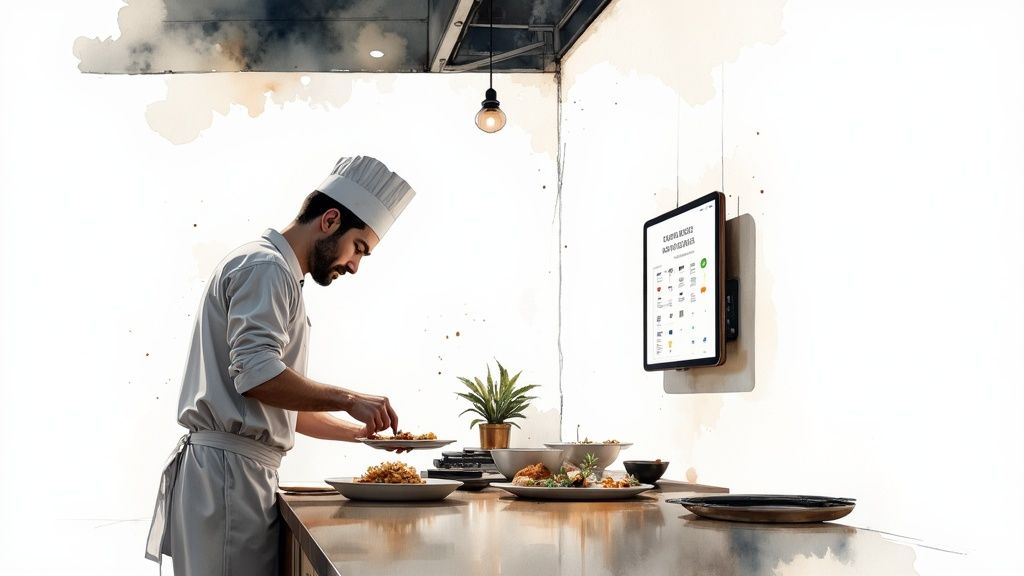Discover the benefits of online ordering for restaurants and how it boosts sales, speed, and customer satisfaction.

The phone ringing off the hook during dinner rush feels like success, but it’s a bottleneck. Every call pulls staff from serving guests, risks a misheard order, and is a missed chance to upsell properly. Manual phone orders are an expensive, error-prone process that drains time from a lean crew already managing thin margins.
What if you could capture every order, increase its value, and free up your team? This is the core function of a dedicated online ordering system.
This article breaks down the tangible benefits of online ordering for restaurants, detailing how this tech can directly reduce labor costs, improve accuracy, increase check sizes, and provide data to help you make smarter business decisions.
One of the most immediate benefits is lower labor costs. Every phone or in-person order requires a staff member's full attention, pulling them from critical tasks like running food or assisting dine-in guests. This creates operational bottlenecks, especially during a rush.

An online system automates this entire process. Customers browse, select, customize, and pay without staff intervention. This means fewer employees are needed to manage phones, allowing you to reallocate labor to the kitchen and guest services. The result is a more efficient team that can handle higher volume without feeling overwhelmed.
Mishandled orders—a misheard request over the phone or a transcription error during a rush—cost money, waste food, and damage customer trust. These mistakes lead to costly remakes and frustrating complaints.
An online ordering system puts accuracy in the customer's hands. They input their exact preferences and customizations, and that digital order is sent directly to the kitchen. This eliminates intermediaries and significantly reduces errors. Major pizza chains, for example, have reported a sharp reduction in remake costs after promoting online ordering.
One of the key financial benefits of online ordering is its ability to boost the average order value (AOV). Unlike a rushed phone call, an online platform gives customers time to explore the menu fully, encouraging them to add more items to their carts.
Digital menus are dynamic selling tools. They can automatically prompt customers with relevant upsells ("Make it a large for $2 more?") or cross-sells ("Add a side of garlic knots?"). This guided experience leads to more impulse additions, with studies showing online orders are often 15-30% higher than their phone-in counterparts.
An online ordering system is a data collection engine. Every digital order captures information about customer preferences, purchasing habits, and peak ordering times. Unlike anonymous phone orders, this provides data you can use to make smarter business decisions.
The system gathers analytics on which menu items are most popular, when your busiest hours are, and how much your average customer spends. This allows you to move from guesswork to a data-driven strategy, helping you identify and promote your most profitable items during peak online traffic periods.
Traditional ordering is confined to your operating hours. An online platform removes that barrier, meeting the needs of late-night workers, early planners, and anyone with an unconventional schedule.
An online ordering platform operates 24/7, allowing customers to browse your menu and place an order for the next day at 2 a.m. or schedule catering a week in advance. This convenience meets modern consumer expectations and captures revenue you would otherwise miss.
Modern online ordering systems can be a command center for your entire delivery operation. They integrate with delivery platforms, automating dispatch, optimizing routing, and providing real-time tracking that reduces delivery times and improves reliability.

This connection transforms a complex process into a manageable one. When an order is placed, it can be automatically assigned to the best available driver, whether in-house or third-party. Customers get the transparency they expect, with the ability to track their order from kitchen to doorstep.
Online ordering is a powerful tool for keeping existing customers. An integrated platform is the foundation for loyalty programs and personalized marketing that builds habits and drives higher lifetime value.
When customers order through your platform, you capture data on their preferences and order frequency. This allows you to send targeted, personalized offers that are far more effective than generic ads, turning casual diners into loyal advocates.
The shift toward contactless transactions is now a lasting customer expectation. Online ordering enables a completely touch-free payment and fulfillment process, handling payments digitally upfront to eliminate cash handling and physical card exchanges.
This operational change builds trust and shows customers you prioritize their well-being. It streamlines service, enhances guest confidence, and is a powerful differentiator that can attract and retain cautious diners.
Online ordering is no longer optional; it's about how you implement it to protect your margins, not hand control to third-party delivery sites. Taking control of your own online ordering channel is one of the most powerful ways to increase profitability. A direct-to-consumer approach lets you bypass commission fees and reinvest that revenue back into your business.
Your next move is to build your digital storefront. To effectively implement online ordering, exploring the best website builders for restaurants is a crucial first step. A purpose-built website is the foundation for a successful direct ordering strategy, giving you full control.
Ready to stop paying commissions and start owning your customer relationships? Peppr offers a commission-free online ordering system that integrates directly with your POS, designed by restaurants who get it. See how Peppr can put profits back in your pocket.
The phone ringing off the hook during dinner rush feels like success, but it’s a bottleneck. Every call pulls staff from serving guests, risks a misheard order, and is a missed chance to upsell properly. Manual phone orders are an expensive, error-prone process that drains time from a lean crew already managing thin margins.
What if you could capture every order, increase its value, and free up your team? This is the core function of a dedicated online ordering system.
This article breaks down the tangible benefits of online ordering for restaurants, detailing how this tech can directly reduce labor costs, improve accuracy, increase check sizes, and provide data to help you make smarter business decisions.
One of the most immediate benefits is lower labor costs. Every phone or in-person order requires a staff member's full attention, pulling them from critical tasks like running food or assisting dine-in guests. This creates operational bottlenecks, especially during a rush.

An online system automates this entire process. Customers browse, select, customize, and pay without staff intervention. This means fewer employees are needed to manage phones, allowing you to reallocate labor to the kitchen and guest services. The result is a more efficient team that can handle higher volume without feeling overwhelmed.
Mishandled orders—a misheard request over the phone or a transcription error during a rush—cost money, waste food, and damage customer trust. These mistakes lead to costly remakes and frustrating complaints.
An online ordering system puts accuracy in the customer's hands. They input their exact preferences and customizations, and that digital order is sent directly to the kitchen. This eliminates intermediaries and significantly reduces errors. Major pizza chains, for example, have reported a sharp reduction in remake costs after promoting online ordering.
One of the key financial benefits of online ordering is its ability to boost the average order value (AOV). Unlike a rushed phone call, an online platform gives customers time to explore the menu fully, encouraging them to add more items to their carts.
Digital menus are dynamic selling tools. They can automatically prompt customers with relevant upsells ("Make it a large for $2 more?") or cross-sells ("Add a side of garlic knots?"). This guided experience leads to more impulse additions, with studies showing online orders are often 15-30% higher than their phone-in counterparts.
An online ordering system is a data collection engine. Every digital order captures information about customer preferences, purchasing habits, and peak ordering times. Unlike anonymous phone orders, this provides data you can use to make smarter business decisions.
The system gathers analytics on which menu items are most popular, when your busiest hours are, and how much your average customer spends. This allows you to move from guesswork to a data-driven strategy, helping you identify and promote your most profitable items during peak online traffic periods.
Traditional ordering is confined to your operating hours. An online platform removes that barrier, meeting the needs of late-night workers, early planners, and anyone with an unconventional schedule.
An online ordering platform operates 24/7, allowing customers to browse your menu and place an order for the next day at 2 a.m. or schedule catering a week in advance. This convenience meets modern consumer expectations and captures revenue you would otherwise miss.
Modern online ordering systems can be a command center for your entire delivery operation. They integrate with delivery platforms, automating dispatch, optimizing routing, and providing real-time tracking that reduces delivery times and improves reliability.

This connection transforms a complex process into a manageable one. When an order is placed, it can be automatically assigned to the best available driver, whether in-house or third-party. Customers get the transparency they expect, with the ability to track their order from kitchen to doorstep.
Online ordering is a powerful tool for keeping existing customers. An integrated platform is the foundation for loyalty programs and personalized marketing that builds habits and drives higher lifetime value.
When customers order through your platform, you capture data on their preferences and order frequency. This allows you to send targeted, personalized offers that are far more effective than generic ads, turning casual diners into loyal advocates.
The shift toward contactless transactions is now a lasting customer expectation. Online ordering enables a completely touch-free payment and fulfillment process, handling payments digitally upfront to eliminate cash handling and physical card exchanges.
This operational change builds trust and shows customers you prioritize their well-being. It streamlines service, enhances guest confidence, and is a powerful differentiator that can attract and retain cautious diners.
Online ordering is no longer optional; it's about how you implement it to protect your margins, not hand control to third-party delivery sites. Taking control of your own online ordering channel is one of the most powerful ways to increase profitability. A direct-to-consumer approach lets you bypass commission fees and reinvest that revenue back into your business.
Your next move is to build your digital storefront. To effectively implement online ordering, exploring the best website builders for restaurants is a crucial first step. A purpose-built website is the foundation for a successful direct ordering strategy, giving you full control.
Ready to stop paying commissions and start owning your customer relationships? Peppr offers a commission-free online ordering system that integrates directly with your POS, designed by restaurants who get it. See how Peppr can put profits back in your pocket.
